Times have changed since Kathleen DesMaisons, PhD, author of the 1998 book Potatoes Not Prozac, first recommended the starchy tuber as a bedtime intervention for people struggling with addictions. That was before the carb phobia that turned potatoes into public enemy No. 1.
“I’m Irish, and potatoes weren’t scary back then,” she says. “They didn’t have the negative connotation they have now. They were just cheap, available, comforting, familiar, and delicious. Thankfully, the pendulum is starting to swing back toward that recognition.”
DesMaisons was running a treatment center at the time, and she hypothesized that eating a skin-on baked potato three hours after dinner could help enhance the production of the feel-good neurochemical serotonin — something that’s commonly depleted in people who are in early recovery. Potatoes can help heal a sugar addiction as well, she argues, because they can help heal the brain’s biochemistry.
“Many of us are feeling terrible these days — it’s as if we’re collectively suffering from cultural PTSD,” she notes. “A simple timed snack like a potato helps rebuild the brain and restore serotonin levels.”
More than just a mood-boosting comfort food, the potato is also a powerful, economical source of many key nutrients.
So how did it fall so far out of favor, especially considering that humans have been enjoying the tubers for the past 10,000 years, since they were first cultivated by the Inca in what became Peru? Shifting nutritional trends is the most likely explanation, says DesMaisons.
Advocates of low-carb strategies like the paleo diet, ketogenic diet, and the Whole30 plan have called potatoes’ value into question — and even occasionally kicked them to the curb. The tuber’s relatively high carbohydrate count and (potentially) high glycemic index is only part of the issue for some critics; another factor is that potatoes are part of the nightshade family of vegetables, which includes tomatoes and eggplant. Nightshades have been linked to leaky gut syndrome for some people.
Finally, the fact that potatoes are most often consumed as French fries and potato chips — by no fault of their own! — has also led to a bad reputation. These prepared and processed forms offer little nutritional value.
While these concerns are understandable, an all-or-nothing view of this vegetable overlooks a great deal: The humble spud deserves a place in a diverse diet of whole foods for a variety of reasons.
The Return of the Potato
Potatoes were originally nixed by the Whole30 plan because they’re so often consumed as fries or chips. But the veggie’s nutritional muscle eventually swayed the Whole30 team, and white potatoes are now allowed on the plan — just not in highly processed forms.
“Potatoes are a low-cost way to get a range of vitamins and minerals in generous amounts, especially if you keep the peel on,” says Whole30 education manager Stephanie Greunke, MS, RD. “They’re also a good source of fiber.” This includes prebiotic fiber, she adds, which is necessary for feeding and sustaining the beneficial bacteria in the gut.
Potatoes are a low-cost way to get a range of vitamins and minerals in generous amounts, especially if you keep the peel on.”
To get the most from potatoes, it’s best to think beyond the fryer. Greunke recommends baking; boiling; and roasting, ideally in a fat with a high smoke point, such as ghee. “These are all better options than deep frying in vegetable oil,” she notes.
Potassium is one of the most critical nutrients potatoes provide. While most of us understand our need for ample magnesium and calcium, we often overlook the importance of potassium, which supports a variety of vital physiological processes, says Shena Jaramillo, MS, RD, who specializes in plant-based nutrition.
“As an electrolyte, potassium regulates fluid shifts in and out of every cell in the body,” she notes. “It’s also a key ingredient in maintaining bone-mineral density. And potatoes are packed with potassium, as well as B and C vitamins. You’ve even got iron in there, so potatoes are truly a nutrient-dense food.”
Again, preparation matters. To maximize potassium, use a dry-heat cooking method like roasting, suggests functional nutritionist Jesse Haas, CNS, LN.
If you’re going to use a moist-heat cooking approach, like boiling or steaming, leaving the skin on will help retain water-soluble vitamins B and C.
Finally, it’s especially important to choose organic whenever possible. Per the Environmental Working Group’s 2021 Shopper’s Guide to Pesticides in Produce, conventional potatoes contain some of the highest pesticide levels of any vegetable or fruit — and these are concentrated in the skin, right alongside the nutrients and fiber.
The Carb Conundrum
Just as potatoes have come into question over the years, so have carbohydrates writ large. Yet most nutrition experts are quick to point out that not all carbohydrates are created equal. The type found in potatoes, for example, is a complex form called amylose, says functional-medicine-trained dietitian Heidi Moretti, MS, RD.
“This means that when you eat potatoes, they digest more slowly than sugar, which is a simple carb,” she explains. “Because they have carbs, potatoes can increase blood-sugar levels, but the way they’re prepared and what you eat them with can change this drastically.”
Because they have carbs, potatoes can increase blood-sugar levels, but the way they’re prepared and what you eat them with can change this drastically.”
For example, if you drizzle extra-virgin olive oil on a boiled potato and serve it with protein, she says, you will soften its effect on your blood sugar.
Different potatoes also have different starch levels. Waxy varieties, like fingerling or red potatoes, have lower starch. They have a milder blood-sugar impact than their starchier counterparts, like russets, which are most commonly used in fries and chips. (Avoid these preparations and you’ll also avoid the trans fats that usually accompany them.)
Finally, as with most dense carbohydrate sources, moderation is important.
“If you eat a small amount of potatoes, like half a cup, your blood-glucose impact will be much less than if you eat a big serving,” explains Moretti.
Foundational Fiber and Resistant Starch
If you want to prevent a blood-glucose spike when eating any potato, eat it cold. Cooking and then cooling potatoes boosts their level of resistant starch: The fibers become denser and harder to digest (that’s where the “resistance” comes in). They then make their way into the colon, where they are fermented by the beneficial bacteria in your gut.
“All fibers feed this bacteria and yeast, but resistant starches fuel the production of a short-chain fatty acid called butyrate that has many health impacts, including maintenance of the mucosal membranes in the large intestine,” Haas says. (Butyrate plays a surprisingly big role in overall health. Learn more at “The Health Benefits of Butyrate.”)
If you want to prevent a blood-glucose spike when eating any potato, eat it cold.
Healthy GI mucosal membranes have been shown to lower the risk of colon cancer and inflammatory bowel disease. Plus, robust gut health is associated with a range of other benefits, such as streamlined digestion, a stronger immune system, lower risk of autoimmune diseases, and deeper sleep. It’s even been found to ease depression and inspire a better overall mood.
All of this means that potatoes don’t need to be saved for an occasional indulgence. They are a key part of a whole-foods diet when prepped right.
Hello, old friend. Welcome back.
A Field Guide to Potatoes
Potatoes come in many forms. Functional nutritionist Jesse Haas, CNS, LN, notes that multiple varieties of potatoes were first harvested by the Inca in what became Peru, and present-day Peruvians have maintained that cultivation. “When I visited Peru, I was completely gobsmacked by how many varieties they use in the Andes: Potatoes come in all shapes, sizes, and colors,” she explains.
“In the United States, we lack a lot of that biodiversity in our diets, and I think we’ll learn more about how important diversity is for health in the years to come.”
You can get that diversity now by bringing a Peruvian approach to your potato choices. The guide below shows starch levels for different varieties, with nutrition information for one 100-gram serving, or about 2/3 cup. (Net carbs are a food’s nonfibrous carbohydrates; they have the greatest impact on blood sugar.)
French Fingerlings
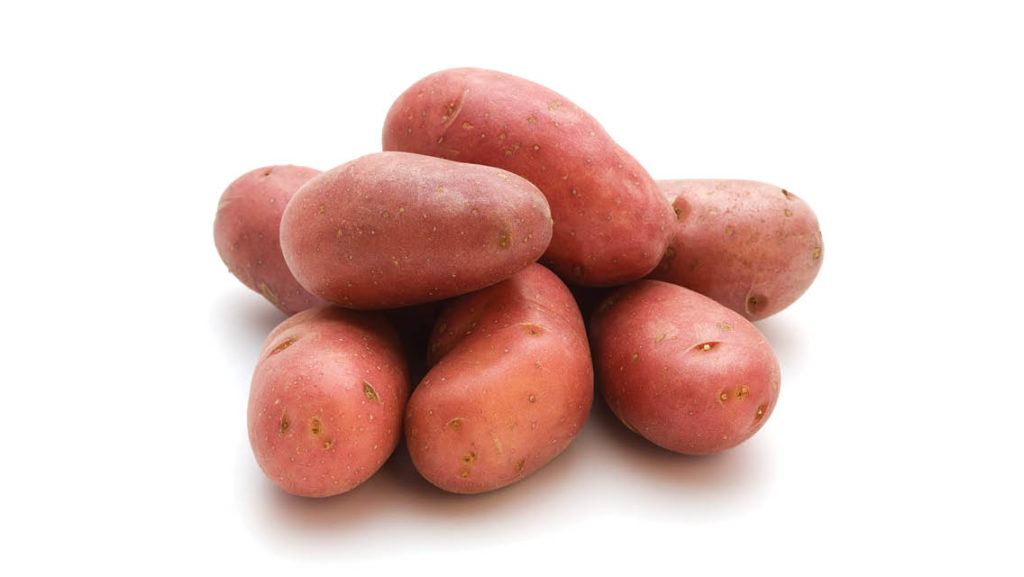 These delicate, low-starch potatoes were developed in France in the 1950s.
These delicate, low-starch potatoes were developed in France in the 1950s.
Characteristics: Pinkish or rosy-red skin; yellow flesh (sometimes with pink streaks); long and narrow shape.
Fun fact: They were once widely called “nosebag potatoes,” after a rumor that they were smuggled into the United States in the nosebag of a horse.
Nutrition: 16 g net carbs, 2 g protein.
Flavor: Almost nutty, with a robust and earthy flavor.
Try Them: Roasted. Because they are smaller and keep their shape so well, and their thin skin softens easily, fingerlings make perfect oven fries. Cut larger ones in half and roast them in the oven with some butter or olive oil and whole garlic cloves. This may satisfy your fry cravings.
Peruvian Purples
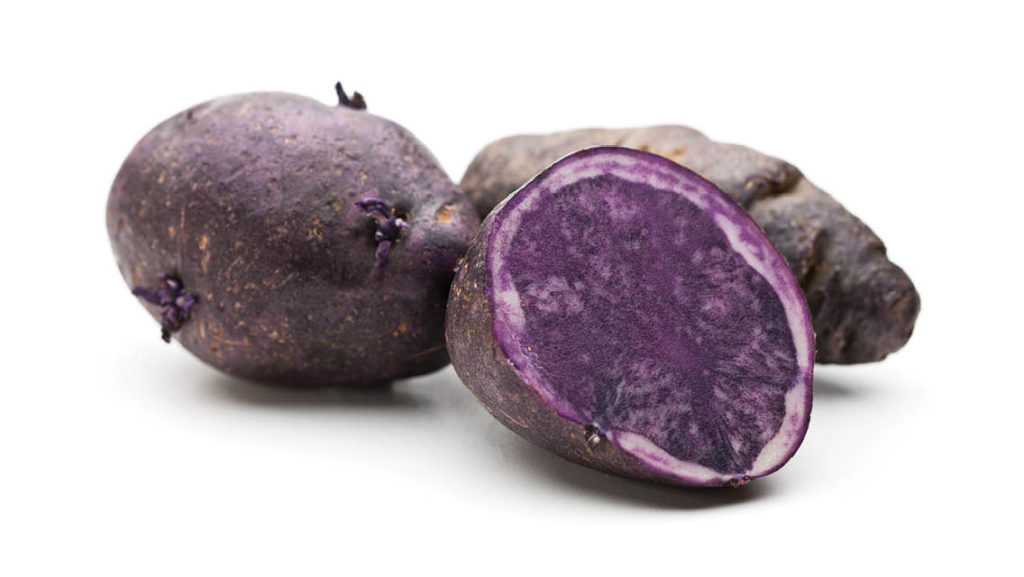 Indigenous to the Peruvian Andes, these are another type of fingerling potato. Other non-Peruvian fingerlings include the Russian banana (developed in the Baltic region) and Swedish peanut.
Indigenous to the Peruvian Andes, these are another type of fingerling potato. Other non-Peruvian fingerlings include the Russian banana (developed in the Baltic region) and Swedish peanut.
Characteristics: Deep-purple skin; violet flesh that’s occasionally marbled.
Fun fact: That rich color, which comes from generations of breeding for deeper purples, means they’re especially high in the phytochemical anthocyanin. Studies have found that this antioxidant, which also appears in blueberries, can help cool inflammation and reduce the risk of cancer and cardiovascular disease.
Nutrition: 16 g net carbs, 2 g protein.
Flavor: Nutty and almost sweet.
Try Them: Mashed or in soup. They retain their color through cooking.
Red Potatoes
 These low-starch potatoes originated in Peru. There’s also a U.S. variety called Red Pontiac or Dakota Chief, which is still one of the most abundant red varieties.
These low-starch potatoes originated in Peru. There’s also a U.S. variety called Red Pontiac or Dakota Chief, which is still one of the most abundant red varieties.
Characteristics: Pink or reddish skin; round shape; light-yellow or white flesh.
Fun fact: The numerous red-potato varieties often have jaunty names, such as Red Sonia, Red Bliss, Lollipop, and Dakota Rose.
Nutrition: 14 g net carbs, 2 g protein.
Flavor: Neutral and mild — even the skin. Because of that, they’ve been called the workhorse of the potato world.
Try Them: Skin on, in potato salad. Red potatoes are incredibly versatile, and they’re the best choice for the cook-then-cool method used for a Nicoise or potato salad.
Yukon Golds
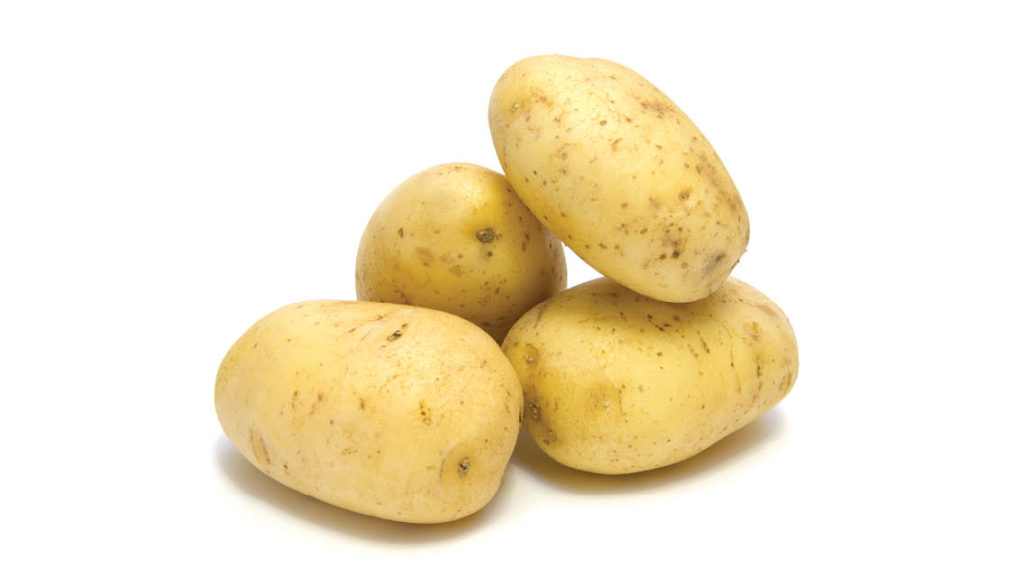 Developed in the 1960s and released in the 1980s in Canada, these medium-starch potatoes are actually a hybrid.
Developed in the 1960s and released in the 1980s in Canada, these medium-starch potatoes are actually a hybrid.
Characteristics: Smooth and yellow-hued skin; oval shape; dense flesh.
Fun Fact: Agriculturists at Ontario’s University of Guelph crossed a North American white potato with a yellow South American variety to create the Yukon Gold, with its light-yellow tone.
Nutrition: 16 g net carbs, 2 g protein.
Flavor: Buttery and mild, almost neutral — that makes them a good base for seasonings and a strong all-around choice.
Try Them: Mashed. Unlike some potatoes that can get chunky or mealy when boiled and mashed, Yukons lean toward creaminess, and the slightly buttery flavor adds to the appeal.
Russets or Idaho Potatoes
 These high-starch potatoes were developed by American botanist Luther Burbank in the 1870s to be resistant to potato blight; he was responding to the Irish potato famine. This variety is still sometimes called the Burbank potato.
These high-starch potatoes were developed by American botanist Luther Burbank in the 1870s to be resistant to potato blight; he was responding to the Irish potato famine. This variety is still sometimes called the Burbank potato.
Characteristics: Usually large; brown skin; dry, white flesh.
Fun fact: Only potatoes grown in Idaho can be called Idaho potatoes; the ones grown elsewhere are called russets.
Nutrition: 19 g net carbs, 3 g protein.
Flavor: Russets have an earthy flavor that pairs well with strongly flavored seasonings.
Try Them: Baked. These make superb classic baked potatoes — with some butter and sour cream to soften the glycemic impact.
Sweet Potatoes and New Potatoes
Despite its name, the sweet potato is not closely related to the potato. They may look similar, and grow under the soil in the same way, but sweet potatoes aren’t a nightshade; they’re part of the morning-glory family.
Much like other potatoes, though, sweet potatoes are packed with nutrition, including fiber, B and C vitamins, iron, and calcium. They’re low on the glycemic index, depending on cooking method, and are often considered a healthy carb, which is why they’re favored in the paleo diet and on a Whole30 reset.
New potatoes, on the other hand, are actually potatoes — but they’re not a variety. They’re simply young potatoes that are harvested before they’re fully grown. Despite this, they still offer plenty of nutrients. (Mature red potatoes are sometimes mistakenly called new potatoes simply because they’re about the same size; real new potatoes have a very thin skin that scratches off easily.)
Keep in mind that new potatoes usually haven’t been “cured,” or subjected to a drying process that toughens their skin and allows them to be stored. So, use new potatoes sooner after buying than you might other varieties.
This article originally appeared as “The Great Potato Comeback” in the March 2022 issue of Experience Life.
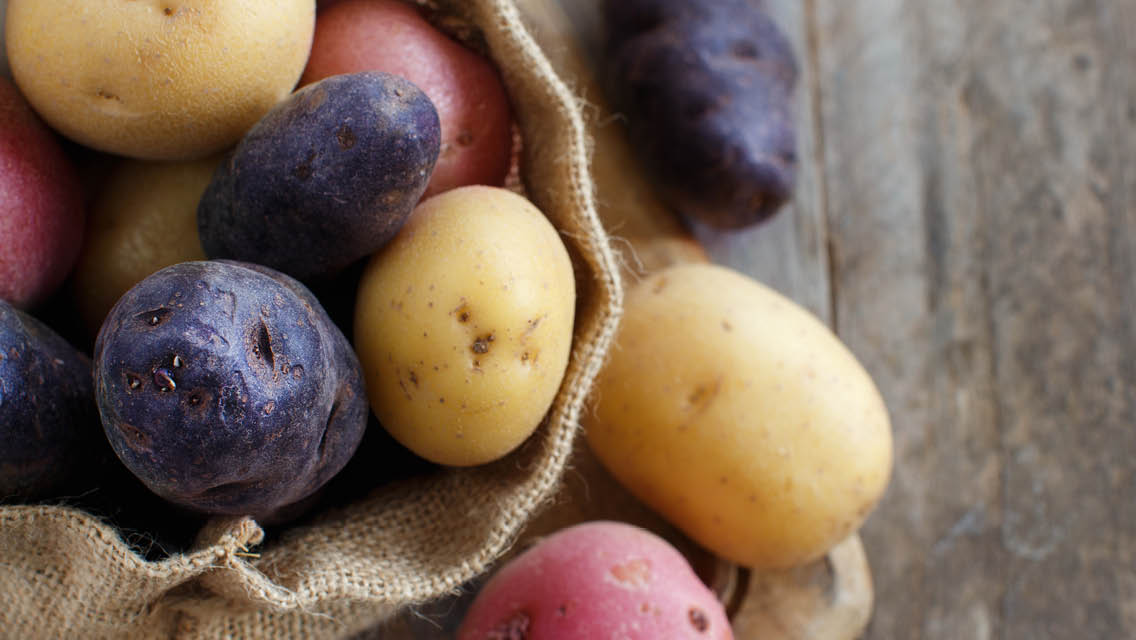


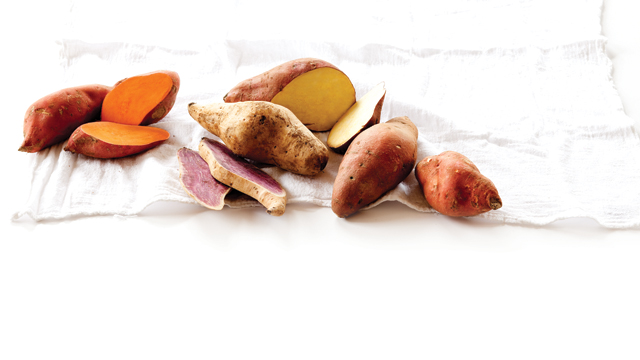
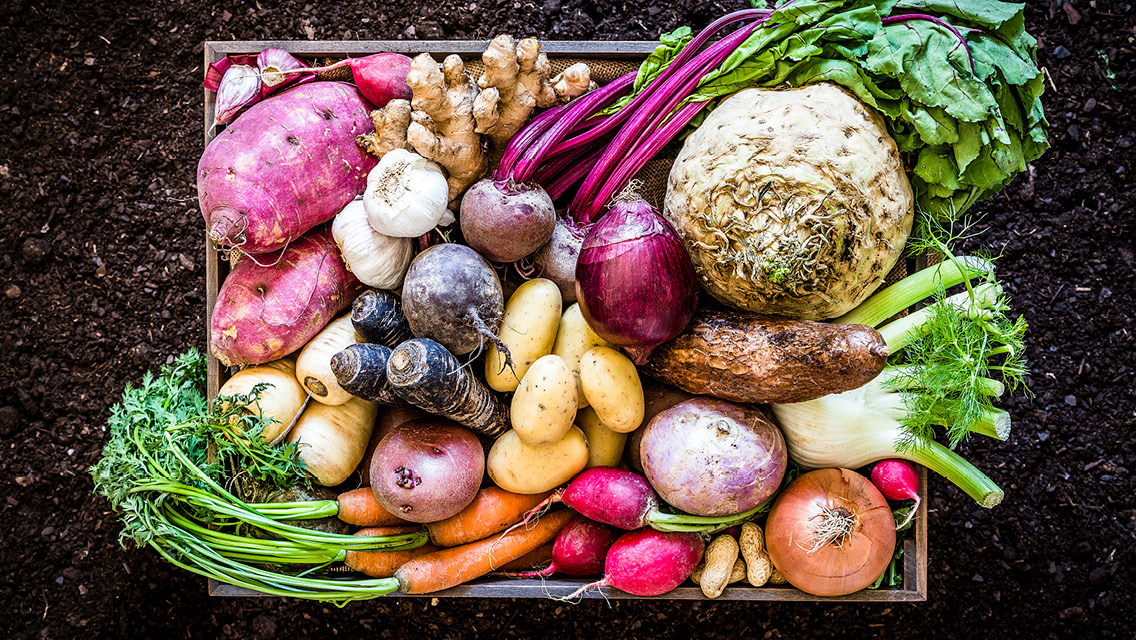
This Post Has 0 Comments